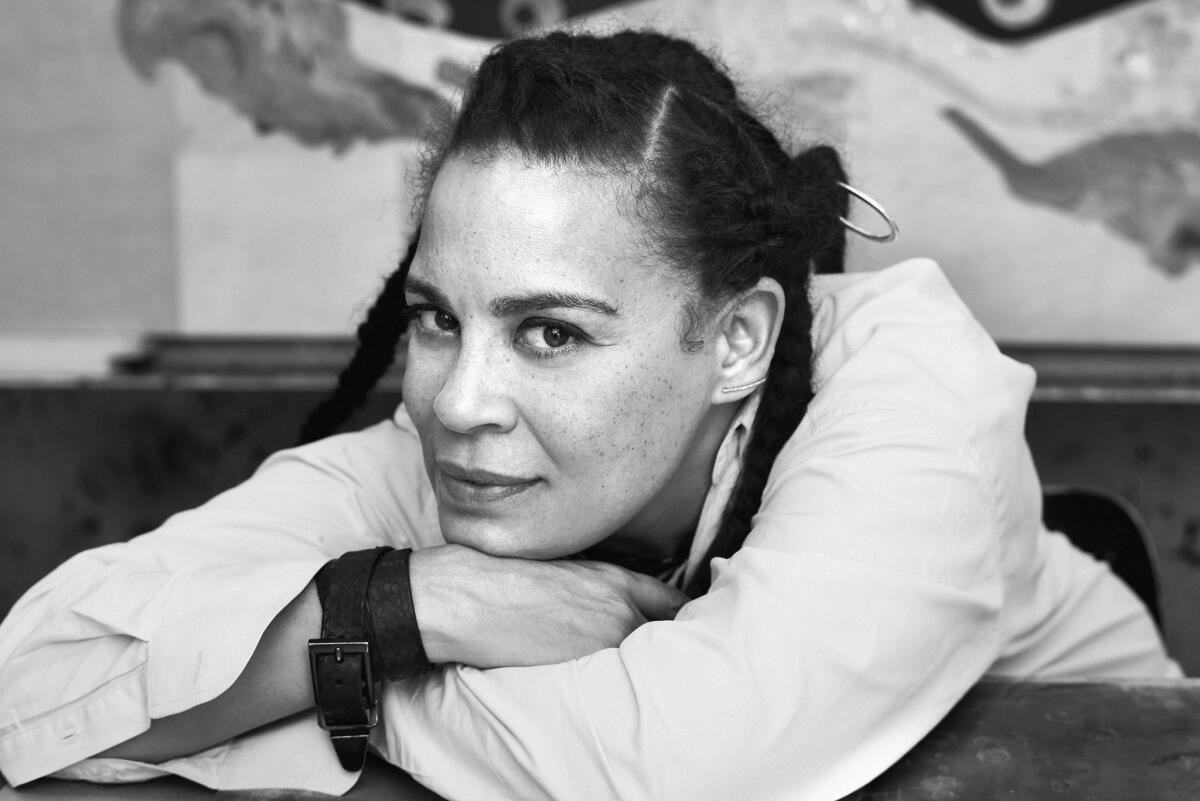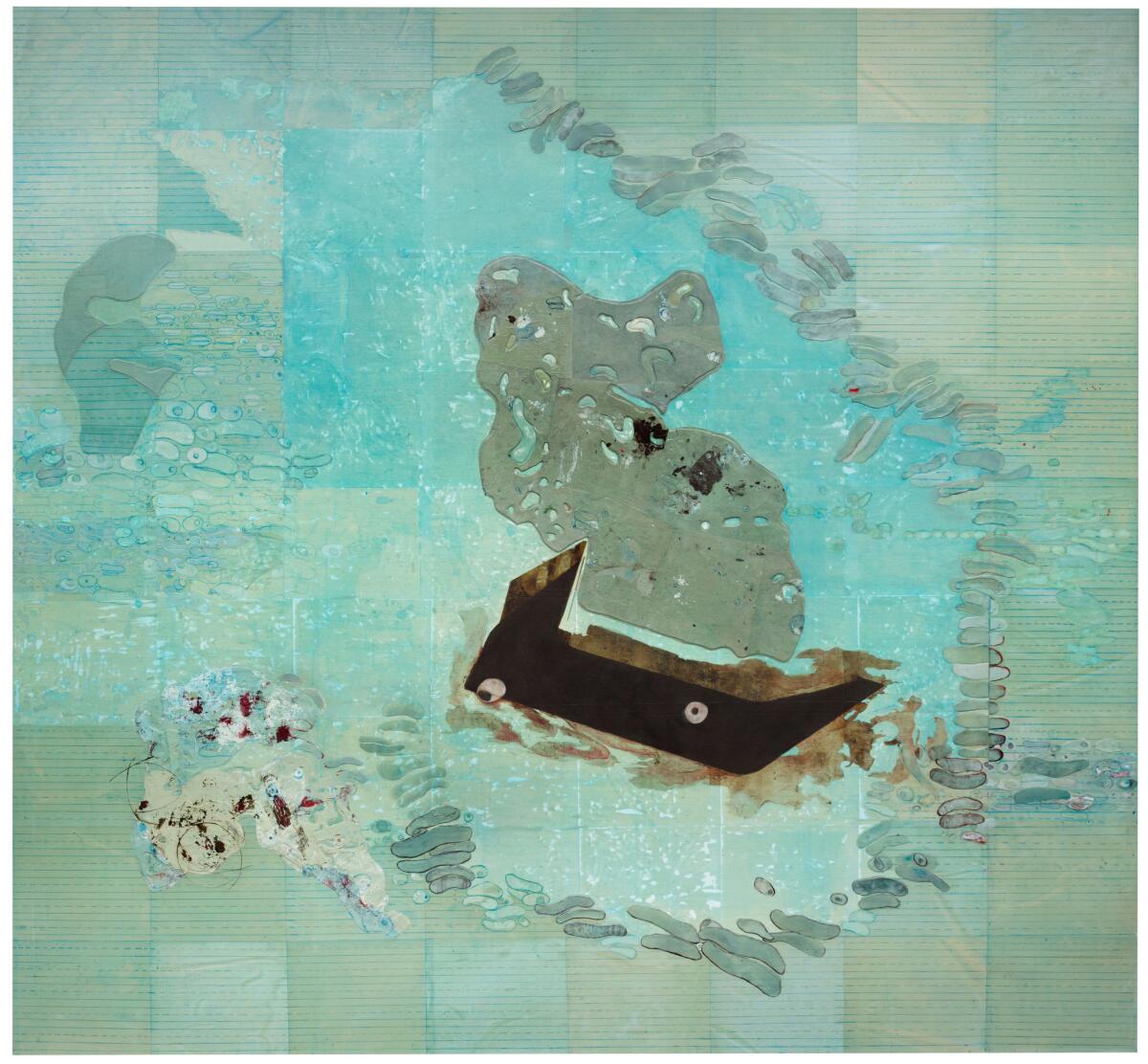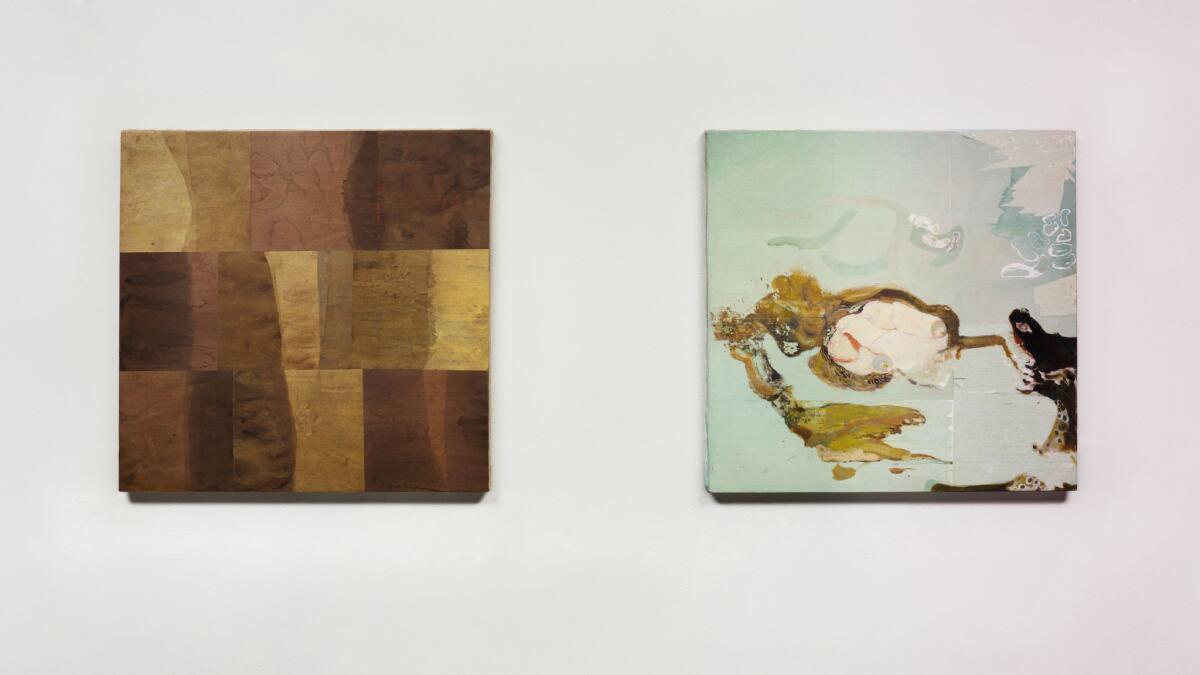Painter Ellen Gallagher’s tragic sea tales: How African slaves went from human to cargo on the Atlantic
On first glance, the painting that greets visitors to the South Gallery at Hauser & Wirth in downtown Los Angeles looks like a crab quietly resting on the bottom of an ocean floor. But look again and that crab morphs into the fragmented face of a person, its myriad pieces coming undone in a watery deep.
In her first solo show in Los Angeles, painter Ellen Gallagher broaches the history of the Middle Passage in ways that are both poetic and surprising — rendering underwater scenes that seem perfectly innocent at first glance, but that on second, third and fourth viewing, quietly evoke the terrible tragedies that occurred in the Atlantic Ocean during the roughly four centuries of the slave trade.
“These are history paintings,” she says thoughtfully, as she settles into a sleek chair in a small lounge at Hauser & Wirth. “It’s this portrait of this space in between, this space where you are dead and alive at the same time.”
The artist, who divides her time between New York and Rotterdam, and whose work resides in the permanent collections of the Museum of Modern Art in New York and the Museum of Contemporary Art Los Angeles, has long explored questions of history and power in works that straddle the gray area between figurative and abstract.

In one series, she created elaborate grids that, from afar, appear to be abstracted lines that squiggle and pulse. Get in close and you realize that those squiggles are the bulging eyes and exaggerated lips that have historically been employed in minstrelsy.
The Atlantic Ocean wasn’t simply a conveyance of the slave trade, it was ... a place of transformation from human to cargo.
In another series, Gallagher, who is biracial, reprinted large-scale versions of the vintage wig ads from African American magazines such as Ebony. She then took the reprinted ads, which feature row upon row of headshots of black women modeling the latest styles, and proceeded to cover the women’s heads in sci-fi-esque Plasticine helmets.
The ads raise the issue of how black women have been pressed to adapt to white standards of beauty. But they also reveal the ways in which they have seized these looks and made them their own. In Gallagher’s pieces, demure wig-wearing ladies become an army of fantastical warriors.
Since 2001, the artist has worked on a series titled “Watery Ecstatic,” which she describes as “my version of scrimshaw” — the elaborate carvings commonly rendered on whalebone and connected with the sea-faring cultures of the 18th and 19th centuries.
Gallagher is intrigued by stories of the sea — of the whale ship Essex, which was sunk in the Pacific Ocean by a rambunctious 85-foot whale in 1820, an event that inspired Herman Melville’s “Moby Dick.” And she is equally intrigued by “Moby Dick.” (It’s probably worth noting that, as a young woman, Gallagher, who grew up in the port town of Providence, R.I., spent a summer on a fishing boat in Alaska.)
Of “Moby Dick,” she says, “I think of it as an Afrofuturist text.”
There is the sinister whiteness embodied in the whale. There is Queequeg, the Polynesian harpooner, rendered by Melville not as a collection of stereotypes but as a full flesh-and-blood character. And there is Pip, the black cabin boy from Connecticut, who is traumatized after falling into the ocean.
“There’s this scene where Pip goes overboard, and his brown head is against the calm sea and blue sky, and he loses his mind,” she explains. “It’s like he’s held up by these phantasmagoric terrors. The terror of drowning, the terror of the below you can’t see.
“It’s this portrait of the Middle Passage. His body has survived, but his mind has not.”

His body has survived, but his mind has not.
— Ellen Gallagher, artist
In her latest paintings, Gallagher considers the ways in which the Atlantic Ocean wasn’t simply a conveyance of the slave trade, it was a geography rife with meaning: a place of transformation from human to cargo, a graveyard for people whose place on land had been called into ruthless question. On these harrowing journeys, the sick and the weak were often ruthlessly thrown overboard — highlighted by the case of the slave ship Zong, whose captain tossed 133 enslaved people into the Atlantic in 1781 due to a lack of drinking water and fears of illness, then turned around and claimed their value with the ship’s insurer.
But as much as Gallagher considers death, she also considers life — such as the legend of Drexciya (developed by the electronic music duo of the same name), which imagined an underwater colony inhabited by the children of the pregnant slave women thrown overboard.
“This idea of birth through death,” says the artist, “this deathscape as a birthing of a kind of being.”
The faces in her seabed paintings may be fragmented. But they are very much alive.

Gallagher’s exhibition, titled “Accidental Records,” features other works, too. There are the nearly all-black paintings from the artist’s “Kapsalon” series, inspired by a Dutch word that means “hair salon” or “barber shop,” but also describes a Rotterdam dish with North African origins (French fries topped with shawarma meat and cheese).
“It is this relational space between black and brown men,” she says. “I find it very moving.”
For Gallagher, that sense of movement, of in-between states — between death and life, between the Western and the African, between an ocean’s surface and its depths — is what inspires her.
“I think about Rubens and Dürer traveling,” she says. “The idea of traveling to see and depict. I find that really poignant. It’s important to me as an artist, that displacement, that sense of arriving and departing. It’s an ancient part of being an artist. We’ve gotten weirdly wrapped up in the nation state. But when you think about the black being, you can make your space with people of color. And the potential of that is so radical — to not have your circumference limited by whoever was your most recent master.
“There’s something intense and empowering about that.”
[For the record, 12:33 p.m. Nov. 17, 2017: An earlier version of this post said that the character Pip in Herman Melville’s “Moby Dick” was from Alabama; Pip was from Connecticut.]
“Ellen Gallagher: Accidental Records”
Where: Hauser & Wirth, 901 E. 3rd St., downtown Los Angeles
When: Through Jan. 28
Sign up for our weekly Essential Arts & Culture newsletter »
ALSO
Review: Mike Kelley's Superman moment: 'Kandors' at Hauser & Wirth
How Ed Sullivan, girls gone wild, an alligator and blindfold painting shaped the art of Kim Dingle
The 'whoa' moment and Mary Corse: The painter who toys with light is finally getting her due
The biggest entertainment stories
Get our big stories about Hollywood, film, television, music, arts, culture and more right in your inbox as soon as they publish.
You may occasionally receive promotional content from the Los Angeles Times.




